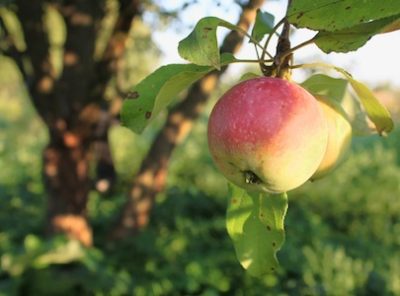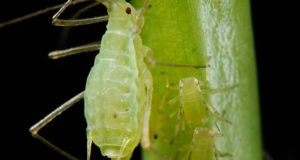Apple trees are a bit like children. Discipline them too harshly, and they become petulant and rebellious. Set no limits, and they become unruly and unproductive. But give them consistent pruning and training, and they form an attractive, useful landscape tree which produces high-quality fruit for years to come.
Establishing Young Trees
Your first interactions with your apple trees begin immediately after planting. If you’ve planted a one-year-old whip, cut the top three to four inches off the top to promote side branching. This top will be your central leader and should always be the tallest point of the tree. If you plant a larger tree, prune it as you would a slightly older tree.
During the second year, prune the tree to develop the first scaffolding branches. Select four or five strong, healthy branches that sit at least twenty-four inches from the soil surface. These branches should be evenly spaced around the tree, neither directly across from each other or right next to each other. Cut all other branches back to the trunk.
The following year, make heading cuts to remove lateral branches that are growing vertically or which grow within a few inches of other branches. You’ll also start training the second tier of scaffolding branches. This group of branches sits about eighteen inches above the first tier. Remove all other branches. Within the third or fourth year, the third tier of scaffolding branches develops. Your goal as you choose scaffolding branches and do this early pruning is to create a well-balanced tree with a Christmas tree sort of shape. The higher branches should always be shorter than the lower branches so light penetrates the bottom of the tree. The entire tree should have an open form so air and light reaches every portion.
Also, choose branches that have wide crotches. If you look at the tree, you’ll notice that some branches connect to the trunk and grow vertically, creating very little space between the trunk and the branch. Other branches have a more horizontal form so there is plenty of space between the branch and the trunk. These branches are stronger and healthier and will produce a more pleasing form. In some cases, you can create more space through training (see below).
Pruning Established Trees
Don’t neglect early training and pruning. This early work will simplify any later pruning. To care for established trees, keep in mind your end goal of creating a healthy form that allows light to permeate. First, remove any water spouts and suckers. These soft vegetative growths grow out of the trunk of the tree, as well as the branches. They serve no purpose and divert energy from fruiting. Then, cut back branches on your second and third tiers that have become longer than the bottom layer of branches. Cut back these branches to old wood and make the cut directly above an outward facing bud. Here’s why: anytime you make a thinning cut, you encourage more growth, which can be a problem. If you cut back to old wood, the growth is less pronounced than if you cut into young, vigorously growing wood.
A guide that delves even deeper into the mysteries of growing good fruit with minimal inputs.
Remove any limbs that grow vertically or grow downward. If two branches rub against one another, remove the weaker one. If you must remove other branches to let in light, choose the weakest ones first. Make these cuts, which are known as heading cuts, by cutting back to where the branch joins another branch or the trunk. When cutting branches back to the trunk, you’ll notice a small collar, or bump, where the branch joins the tree. Cut the branch off in this collar, rather than making the cut flush with the tree.
Finally, when the tree has reached its desired size, you can control its growth simply by cutting the leader back every year.
Training Branches
The purpose of training a tree is to bend the branches into the best possible form. When branches grow vertically, they produce lots of leaves, but few fruit. Branches growing horizontally produce abundant fruit, but few leaves. The best angle, then, is somewhere between these two extremes – at about a sixty-degree angle from the main trunk. To train branches, secure them with clothespins or pound a stake into the ground and secure them to the stake with soft cotton rope. Another method is to hang weights from the branches. The weights should sit halfway between the trunk and the tips of the branches.
Begin training branches when the tree is very young and start training on soft, short branches. The wood of older branches is harder and less pliable. Training is generally necessary during the early years of an apple tree’s life. Once the tree has assumed its form, you no longer need to train it.
Tips For Success
- Prune apple trees when they are dormant, in late winter to early spring. The tree’s form is more apparent without the foliage, and you’re less likely to spread disease.
- When pruning out diseased portions, such as those affected by fire blight, prune back to at least twelve inches beneath the diseased area. Disinfect your tools by dipping them in a solution of one part chlorine bleach to ten parts water between cuts. The bleach solution can be corrosive, so rinse the tools after use, dry them well, and apply a light coating of oil.
- Speaking of tools, buy the best you can afford and take good care of them. In general, you’ll need a hand pruner, a bypass lopper, and a pruning saw. Clean them after each use and sharpen them with a file. Store them in a dry shed or garage.
- Avoid pruning too heavily, which will encourage vigorous vegetative growth and require even more pruning. On the other hand, don’t be timid. “When in doubt, prune it out.” Every apple tree has a slightly different growth pattern and vigor, depending on growing conditions, the cultivar, and the rootstock. Watch your tree and adapt your pruning style accordingly. Learn from your mistakes, and you’ll soon become an expert.
- You might be wondering about restoring old, neglected trees. Pruning an overgrown apple tree is a challenging task because the cuts needed to restore order are usually so large that they encourage a lot of new growth, which requires even more pruning. Unless a tree has sentimental or heirloom value, you’re usually better off removing the old tree and replacing it.
©2013 Off the Grid News
 Off The Grid News Better Ideas For Off The Grid Living
Off The Grid News Better Ideas For Off The Grid Living





